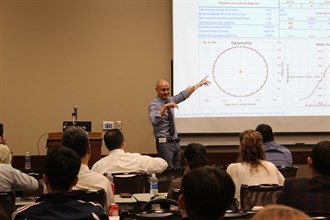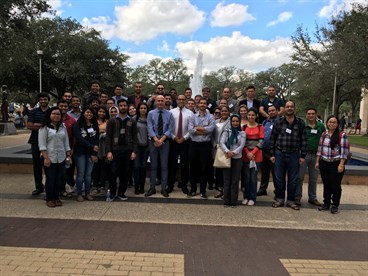 The Texas A&M University student chapters of the Geo-Institute and Structural Engineering Association of Texas recently hosted a workshop on the application of Fast Lagrangian Analysis of Continua in 3 Dimensions (FLAC3D) computational modeling in geotechnical and structural engineering. Augusto Lucarelli, senior engineer at Itasca Consulting Group, Inc., the developing company of FLAC3D, was the guest speaker.
The Texas A&M University student chapters of the Geo-Institute and Structural Engineering Association of Texas recently hosted a workshop on the application of Fast Lagrangian Analysis of Continua in 3 Dimensions (FLAC3D) computational modeling in geotechnical and structural engineering. Augusto Lucarelli, senior engineer at Itasca Consulting Group, Inc., the developing company of FLAC3D, was the guest speaker.
The workshop emphasized the utility of the state-of-the-art numerical simulation tools in FLAC3D. These tools allow engineers to better study, understand and design structures with the highest levels of efficiency and safety. Users of the program have been able to enhance their designs, improve weaknesses, and in some cases, prevent disastrous errors. One of the main goals of the workshop was to provide an in-depth understanding of numerical simulation tools to graduate students who will soon be responsible for the design of various structures.
Over the course of the workshop, Lucarelli gave five lectures, each about a different application of FLAC3D, a numerical modeling software for geotechnical analyses of soil, rock, groundwater, constructs, and ground support. FLAC3D has applications in civil engineering as well as mining, geotechnical excavations, soil, rock and more.
Lucarelli spoke on numerical modeling in geotechnical engineering, slope stability, foundations and soil improvement, finite element application and retaining walls, excavations, seismic, and liquefaction and lastly, tunnels and subways.

The workshop set out to introduce the application of FLAC3D, a typical geotechnical engineering software, to the graduate student body as well as faculty members. By providing a unique experience of direct interaction between students, faculty members and a senior engineer in the developing company, the event was able to showcase and discuss state of the art applications of numerical simulations in the geotechnical and structural engineering industry.
Contributing author: Ryan Terry